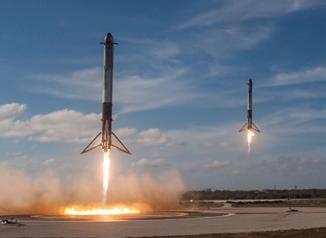SPACEX
THE END OF DISPOSABLE ROCKETS Two-thirds of the Falcon Heavy rocket – the two boosters – make a pas de deux return to the Kennedy Space Center in February 2018. Of the 30 attempts at landing on a sea platform, twenty-five have been successful. With experience, failures have become the exception, not the rule.
16 | NICKEL, 2, 2020 NICKEL, VOL. VOL. 35, Nº35,2,Nº 2020
No, it hasn’t happened yet but the brave beginning is over. Launch-and-recover is in the process of being made ordinary: SpaceX has over 50 recoveries of the first stage of Falcon 9 rockets, and three first stages have been launched five times. The rapidly and economically reusable module for taking humans to space – the SpaceX Crew Dragon – returned triumphantly on 2 August, 2020. No longer with that ‘new space capsule smell’, the craft will be used again, perhaps with the soot washed off. It’s been dramatic but the focus has been more on the tubes, not the ten Merlin engines (nine for the first stage, one for the second). Each time a first stage lands, it lands with its nine Merlin engines intact, ready to be refueled and re-used. The goal is ten launches before
refurbishment and re-entry into service. The ultimate service life is not known but the approximately 1125 kg of nickel-containing alloys will ultimately be recovered and recycled…except for whatever goes to museums as evidence of human ingenuity and ambition.



